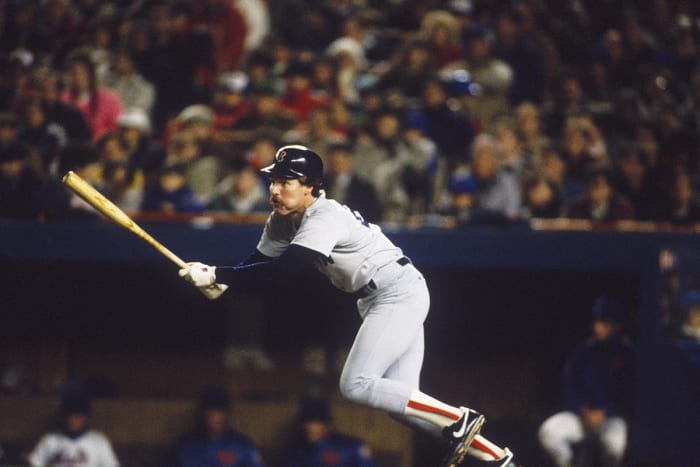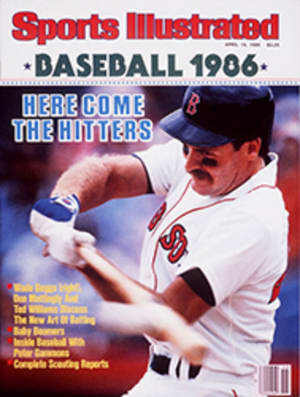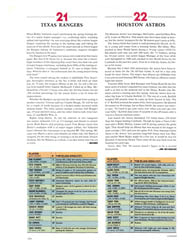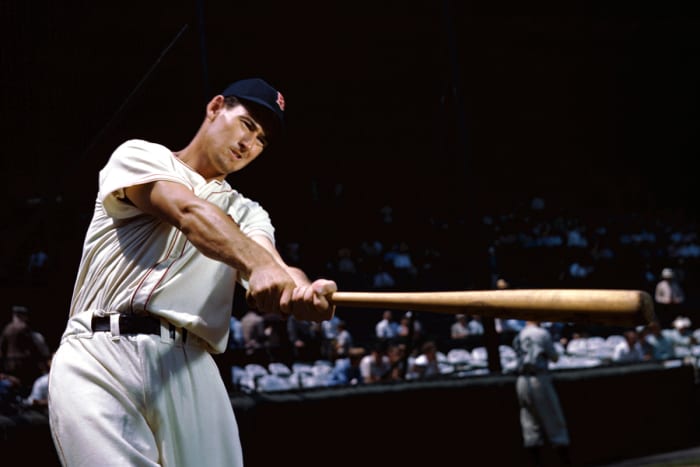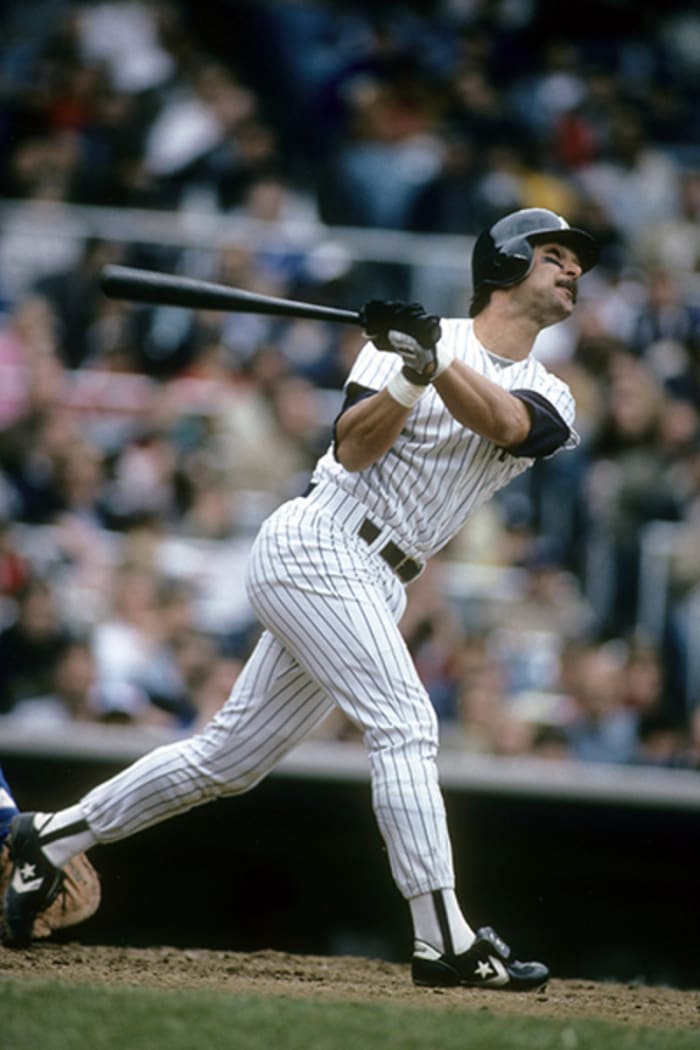A Real Rap Session
Ted Williams and Wade Boggs had been talking nonstop from the time they left Winter Haven, Fla. 70 minutes earlier. The two batting champions were on their way to a rendezvous with yet another, Don Mattingly, when Williams, in the backseat, posed a question to Boggs, who was in the front.
"Have you ever smelled the smoke from the wood of your bat burning?" asked Williams in a voice not unlike that of John Wayne.
"Whaaat?" said Boggs.
"The smell of the smoke from the wood burning?"
"What are you talking about, Ted? I don't understand."
"Five or six times, hitting against a guy with good stuff, I swung hard and—oomph—just fouled it back. Really hit it hard. And I smelled the wood of the bat burning. It must have been that the seams hit the bat just right, and the friction caused it to burn, but it happened five or six times."
Boggs shook his head. "Awesome."
Five minutes later the pair of Red Sox sat down at Tio Pepe, a Clearwater restaurant popular among baseball people, for a dinner arranged by Peter Gammons of SI. Mattingly soon arrived from the Yankees' afternoon game in Sarasota—"Nice to meet you, Mr. Williams," he said—and for the next 2½ hours, three great lefthanded batters talked hitting.
Before we listen in, it should be explained that Williams, who still instructs the Red Sox in hitting during spring training, has long held the belief that the theories of the late Charley Lau "may have set hitting back 25 years." Williams's The Science of Hitting, which remains a classic work on batting, stresses the discipline of the hips, while Lau's The Art Of Hitting .300 teaches the discipline of the head and the importance of shifting weight. What was particularly galling to Williams was the fact that Lau's leading disciple. Red Sox hitting coach Walt Hriniak, was practicing nearby under his very nose. Hriniak is Boggs's mentor, while Mattingly's teacher is Lou Piniella, who learned from Lau in Kansas City. So in rounding up the three men for both dinner and discussion, Gammons brought together two apparently different philosophies. Yet the three ended up agreeing on the fundamentals of hitting.
Be forewarned that some of the technical debate in the beginning may be, like a Ryne Duren fastball, over the head. But the three proved worth listening to. As they conversed, players and coaches from other teams came up to the private dining room to eavesdrop.
WILLIAMS: Don, I haven't had the opportunity to watch you and the Yankees as much as I would have liked in the last year or so. But I'm impressed, very impressed. That [Mike] Pagliarulo looks like a good young hitter.
MATTINGLY: He's getting better. He's learning, it seems like more and more. He's trying that weight-shift thing, and getting back seems to help.
WILLIAMS: What do you mean? Tell me about the weight shift.
MATTINGLY: Just transferring from back to forward. It has helped me a lot. When I was in the middle of my body and my head was in the middle of my body, I was always right here. [He puts his hands tight to the middle of his body.] I was always inside-outing the ball, and I was popping up the ball away. So when I went here [leaning on his back foot], then went to there [striding forward], I got on top of the ball more, and I could pull the ball inside. It allowed some kind of freedom. I think you don't agree with me.
WILLIAMS: I don't think what you're telling me is right. My impression is that, even with all your great success, you don't really realize what you're doing.
MATTINGLY: I think I realize what I'm doing. I don't believe in the total Lau thing, but I think I need some sort of weight shift to hit the ball with more power. It's simple: I have to go back before I can go forward. It has helped me to put the ball in the seats, which I never did before. I always got a topspin, and I'd hit the ball to the warning track. Now I get the backspin, and the ball carries for me. Everything before was an uppercut and I was hitting on top of the ball, so I was getting line drives that would drop down.
WILLIAMS: What you're saying is that you're swinging down on the ball and—get me some paper, O.K. There's a great thing in life called logic. If you say you like to swing down....
MATTINGLY: I didn't say that. I just said I like to get backspin on the ball.
WILLIAMS: O.K. You want backspin, so you're cutting the ball. We'll say you're swinging level. At the moment of impact, in order to hit the ball just right and cut it, you have to hit it on the underneath side with the ball coming slightly down. Now, if I swing slightly up, I hit it with the greatest impact. This swing incorporates the single most important thing—not shifting your weight but getting your butt moving, your hips working. Do you believe that?
MATTINGLY: Yes, definitely.
WILLIAMS: [Standing in back of Mattingly.] Try to swing down. There's no hip movement at all there. If Don Mattingly wants to swing up, you're pretty well forced to move your hips, are you not? Two reasons I like slightly up. First, it incorporates your hips, which makes it possible to be quick and fast. Second, you're hitting in the exact plane of the pitch.
BOGGS: How do you think I swing?
WILLIAMS: You swing up a little, but you practice, practice that down stuff. [He puts his head down and chops downward. Boggs gets up and swings, keeping his head down.] Yeah, that downswing. Since whatever you practice, you're more inclined to do, that's what you do in games. Everyone tells me that in batting practice you're hitting them out of sight, that you're pulling the ball and getting it in the air and going to hit 30 home runs. Why not in a game?
MATTINGLY: But by exaggerating the downswing—if I'm an uppercutter—I'm not really swinging down in games, but I'm at least going to try to get my hands extended....
WILLIAMS: I want you to show me how you think your hands are. This is funny, because you don't realize what you're doing. Let me ask you something. How do you think your hands are at the moment of contact?
MATTINGLY: It depends on where the ball is.
WILLIAMS: Is your left hand on top of your right hand?
MATTINGLY: I don't know.
WILLIAMS: Ohhhh.
MATTINGLY: Really, I don't—I don't know what my hands are doing and all that stuff. I just know what feels right.
WILLIAMS: Try to open up and hit the way you first showed me. [Mattingly swings with his top hand coming over his bottom hand.]
BOGGS: Ground balls to the right side.
WILLIAMS: NOW this. [He pulls at Mattingly's hands so that Mattingly strains, with his left fist following behind his right.] Which is stronger? No doubt. This is a quick, strong game. I want to get the bat there as quickly as I can. They're going to say, listen to that old man Williams telling those good young hitters what to do, but you're 24 and 27. I've analyzed hitting as much as anyone ever has, and I know you've got to be logical.
MATTINGLY: Didn't you shift weight when you hit?
WILLIAMS: I'm going to ask you what your definition of shifting weight is.
MATTINGLY: The transfer of weight.
WILLIAMS: Where to where?
MATTINGLY: From anywhere—from where the head is to six, eight inches.
BOGGS: All right, let's put it in boxing theory. If a boxer hits you, is he going to generate more power from here [indicates a long punch] or more power from here [short punch].
WILLIAMS: He'll generate more power if he doesn't do a thing, then goes umph with his hips.
BOGGS: You're saying all you do is throw the hips? Nothing else? Where do you get the initial movement in the action-reaction process?
WILLIAMS: [He draws two fighters on a piece of paper.] If this guy strides and puts all his weight on his front foot, his weight's forward. I don't want to cheat myself six or eight inches toward the pitcher. Why give him that?
MATTINGLY: I agree with you. I think you have to wait, then explode. I don't think you have to shift to the front leg.
WILLIAMS: That's what you said earlier.
MATTINGLY: NO, I didn't. Well, I did, but I didn't mean to the extent that you're saying all the Lau people do. What I was always taught was to wait, wait, wait, see the ball and then hit it. I get my weight back—wait, wait, wait, then throw it. [He practices his swing.]
WILLIAMS: But you're not really exaggerating the weight shift there.
MATTINGLY: I'm already leaning back, so I've got to get forward some way. From waiting, where I'm giving myself the extra time to see the ball and the extra leverage, I'm exploding. It's the same thing as you're saying.
WILLIAMS: What's impressing me about the two of you is that you talk sense. I don't think you know yourselves as well as you will. Already you're in doubt about some of the things you do, Don. But they're teaching young hitters to hit down, give the pitchers a big advantage with that weight shift and turn over the top hand with that Lau theory.
BOGGS: No, they aren't.
WILLIAMS: YOU don't think so? If you transfer weight, you tell me how you can get your hands underneath. [Boggs takes his stride.] Exaggerate it a little. [Boggs does.] Now that's transferring weight. [Boggs takes his regular swing.] I don't call that transferring weight.
BOGGS: I do, and so would Walter Hriniak. And I've got pictures at home that people have taken at the point of contact where I almost look like you.
GAMMONS: If you look at pictures, the first movement, the cocking of the front knee, is almost exactly the same.
BOGGS: That's how I learned how to hit. I read your book in high school. My father would see me on television and could call me and tell me what I was doing wrong just by the way my front knee was or wasn't being cocked at the beginning of the swing.
WILLIAMS: Did you think I transferred weight?
GAMMONS: As you start your swing, you cock your front leg, and at the point of contact you're coming up off your back foot ever so slightly. That's a shift.
WILLIAMS: That's a hard thing not to do. It's a very little weight shift, more of an unwinding of the hips. A weight shift upsets balance.
BOGGS: I don't know what else you can call it. O.K., tell me how you think I swing?
WILLIAMS: I think you're balanced. But you talk about shifting weight.
MATTINGLY: All good hitters shift their weight. I can't believe they don't. Show me how you get back.
WILLIAMS: I'm doing it with my hips.
BOGGS: Cock your leg. Where's your weight going?
WILLIAMS: Which way am I shifting my weight?
MATTINGLY: I think you're shifting it back.
WILLIAMS: Only because it's the only way I can stand. O.K., watch me swing. I drop my back shoulder. I don't have to force myself to keep my head down. [Boggs takes his swing.] You're dropping your back shoulder, too.
BOGGS: That's the way I hit, and you try to say I don't hit like that.
WILLIAMS: I didn't say that. I never told you a thing about your swing. Your hands are right, but you don't practice the way you hit. When you get in the cage, you swing through with your head straight down—Dewey Evans pretty near makes me vomit the way he swings.
MATTINGLY: I don't buy that, either.
WILLIAMS: All I've heard around the Red Sox for the last five years is to keep your head straight down all the time, and it's a terrible thing. Mr. Brett does it sometimes and gets himself all screwed up. You know why? There's no way you can complete your swing. These are the things I hear, though. Swing down. Let the bat handle go. Why do you think they let the bat handle go?
BOGGS: To get extension.
WILLIAMS: Nah.
BOGGS: And a follow-through.
MATTINGLY: If I'm hitting the ball the other way, I can't hold onto the bat.
WILLIAMS: Sure you can.
BOGGS: When do you let your hand go?
WILLIAMS: I never let my hand go.
BOGGS: I know. But when do Lau, Hriniak and the guys who preach it say to let your hand go?
WILLIAMS: Just at contact.
BOGGS: Wrong.
WILLIAMS: Just before contact, then.
BOGGS: Wrong. [He takes a swing. His hands separate after the imaginary contact, and his bat follows through.]
WILLIAMS: But that's not the way the Lau people do it.
BOGGS: It is, too. That is the proper way to do it. You do it. [Williams stands up and takes an imaginary swing.]
MATTINGLY: You're letting go somewhere.
WILLIAMS: You gotta let it go some-where.
BOGGS: See.
WILLIAMS: Do you think you miss more balls on top or underneath?
MATTINGLY: I really don't know.
WILLIAMS: Oh, boy. One of the best hitters in the game and he doesn't know. O.K., when you don't hit it good....
MATTINGLY: More often than not, I pop it up. I would say that when I miss, I swing underneath.
BOGGS: Same thing, without a doubt.
WILLIAMS: What is that, early or late?
MATTINGLY: Probably early.
WILLIAMS: It's late!
BOGGS: Fly balls late, ground balls early.
WILLIAMS: When you hit the ball to left-field, do you hit more ground balls or fly balls?
MATTINGLY: I hit more fly balls.
WILLIAMS: As did everyone else who ever played the game. When you pull the ball, you have a tendency to hit more ground balls. You tend to hit the ball on the ground because the toughest thing is to pull the ball and get it in the air. That's the premium, par excellence hit.
MATTINGLY: If you hit the ball on the ground, it's because you don't get your hips open.
WILLIAMS: We're talking about the same things, aren't we? I hope you don't hit .409. Wade, what did I tell you when you were in the minors?
BOGGS: Don't change a thing.
WILLIAMS: I also told you to use the count more. Attack that first-pitch fastball. At 2 and oh and 3 and 1, try to get a fastball you can drive in the air. You should be doing that now. There's no reason you shouldn't hit 18 or 20 home runs.
BOGGS: What's so great about you, Ted, is that you teach the scientific foundations of hitting. I try to do that with high school players.
WILLIAMS: What do you teach?
BOGGS: Slightly up because of the plane of the arc, hit through the ball whether you're a pull or opposite-field hitter. I teach them to keep the head down and on the ball, but I don't try to change them too much.
GAMMONS: DO you realize that you three just agreed that the basics of the Ted Williams and Charley Lau theories are really the same and that you've been debating semantics?
WILLIAMS: I still say that what they do isn't what the Lau book preaches.
GAMMONS: Are there hitters today that you particularly like?
WILLIAMS: I love Dale Murphy. He's really got style. I like Mike Marshall's style. I like Bobby Horner, but Horner hits the pitcher's pitch too much. I like Keith Moreland's style. Greg Brock's got style, and he's got great mechanics; I don't understand why he doesn't do better. Darryl Strawberry's big, strong and really quick. He could eventually get a little more opened up and hit 45 home runs. I love to watch him. When you see him on the ball field, you just can't keep your eyes off him. Guys like that don't come along often. You should have seen Jimmie Foxx. He hit them like Mantle. They had a unique sound.
BOGGS: Don, the next time you're in Boston, look in Fenway for the one red seat most of the way up in the bleachers. That's where Ted hit one. Absolutely awesome.
WILLIAMS: Back to guys who should be good hitters who aren't. They swing at too many pitchers' pitches. You do, too, Don. I know you do. What did you have, 45 walks last year? At least Wade makes the pitchers give him something to hit.
MATTINGLY: I take a lot of first pitches, but after that I hack away.
GAMMONS: How does your approach differ from pitcher to pitcher?
MATTINGLY: If I've got a guy that I feel I can handle everything he's got, then I get right on top of the plate.
WILLIAMS: Do you vary your stance?
MATTINGLY: No, I vary my placement in the box, though. Closer to the plate and back. With a pitcher who can't throw the ball by me, I don't want to give him the outside corner, so I move up.
WILLIAMS: I find it interesting about the movement. If I moved, it was more up and back. I stayed the same distance from the plate most of the time. However, if I had a real sinkerballer who got them low and away, down, down, I might move up an inch and a half toward the plate. I never wanted to let that nibbler get me out.
BOGGS: I never vary my placement in the box. My front foot is right on the plate, my back foot's in the same place and it's been right there, cut and dried, for the last 18 years. Guy who throws hard, be a little bit quicker. Guy who throws the off-speed stuff, slow everything down.
MATTINGLY: What about a nasty lefthander with the ball in on your hands?
BOGGS: You mean like Matt Young?
MATTINGLY: Young, [Mark] Langston, [John] Candelaria. Candelaria I say is really tough.
BOGGS: You haven't had to face Rags [Dave Righetti]. He would definitely be in that group.
WILLIAMS: Who has got the best stuff of any righthanded starter?
BOGGS: Mike Moore of Seattle.
WILLIAMS: Young, Langston, Moore are all with Seattle. I thought Kansas City won the World Series. Who's got the toughest righthanded and lefthanded curveballs?
BOGGS: Bert Blyleven and Mike Witt for righties, Bruce Hurst for lefties.
WILLIAMS: Sinker?
MATTINGLY: Doyle Alexander for me, because he can do so many things with it.
BOGGS: Or Dennis Lamp. He's straight over the top.
GAMMONS: Ted, who was the toughest for you?
WILLIAMS: Boy, Bob Feller had great stuff. I can't name one who was toughest for me, but Eddie Lopat and Whitey Ford were really tough because they never gave me a pitch to hit. Bob Lemon was as tough as anyone. Now, if I could give you any advice, it would be that the tougher the pitcher, the tougher the situation, the tougher the count, the worse the light, the worse the umpires, the tougher the delivery, the single most important thing to think about is hitting the ball hard through the middle. You'll never go wrong with that idea in your mind. As long as you hit, and especially as you get older, hang in there and be quick.
BOGGS: If your name was Webster, not Williams, what would be your definition of a slump?
WILLIAMS: The inability to get hold of a ball and hit it with authority according to my potential.
BOGGS: Are you hitting the ball hard at all?
WILLIAMS: No, I'm not hitting the ball hard. If I'm hitting the ball hard and not getting hits, I didn't worry. I would say, "The law of averages is going to catch up with this ——." Do you guys know what you're capable of? A great hitter should walk three times for every strikeout.
BOGGS: How about twice for every strikeout?
WILLIAMS: Twice isn't good enough. If a hitter like Don isn't walking, he knows he's hitting too many pitchers' pitches. There are some hitters who had pretty good years, but now they're starting to filter down because pitchers know they'll swing at two or three balls. I can name you one in Boston who had some great years, but it's been steadily downhill since then. How the hell could the stupid American League pitchers let this guy hit like he did. They just weren't bearing down on him in the first three or four pitches....
Do you think you make more outs in the air or on the ground?
MATTINGLY: I think more in the air.
WILLIAMS: I tried to hit every ball I ever hit in the air, and I made more outs on the ground than in the air. Wade, I know you make more outs on the ground.
BOGGS: I popped up twice all season. But to me hitting the ball in the air means hitting a line drive, and I hit far more balls in the air.
WILLIAMS: Why do you think [Carlton] Fisk hit so many home runs last year? Because he hit the ball in the air more often.
MATTINGLY: I want to make more outs on the ground. I think I've got a better chance of getting a hit.
WILLIAMS: You know what they would say about Don Mattingly. We'll give him the hit. How many doubles did you have? Triples? Homers?
MATTINGLY: Forty-eight doubles, three triples, 35 homers.
WILLIAMS: They weren't on the ground. That's where your production was, so why hit the ball on the ground?
BOGGS: Perfection—well, maybe not in your eyes, Ted, but in mine—is a line drive and above. Willie Wilson and guys who can run want to get the ball on the ground. I want line drives. Ted, how many balls did you hit into the centerfield bleachers in Boston?
WILLIAMS: Not many. Damn few.
BOGGS: That's where I try to hit every ball. Dead center, above the speaker.
WILLIAMS: I hit only four home runs to left in Fenway.
BOGGS: Hey, I've finally found something I've done more often than you. Cecil Cooper says he has hit only one ball over the Wall in 15 years. George [Brett] says he's hit only four balls off the Wall in all his years. Don hit five in a weekend.
MATTINGLY: Last year was the first time I'd ever hit the Wall, in batting practice or any other time. Then I hit it four or five times in one series.
GAMMONS: Have any of you thought about playing in the opposite ballpark, Ted and Wade in Yankee Stadium, Don in Fenway? Ted, in 1949 you were almost traded for Joe DiMaggio.
WILLIAMS: I would have liked to have played in the Stadium.
BOGGS: I've thought about it, but I don't even like to go to New York. Fenway's perfect for me.
MATTINGLY: I would get into bad habits in Fenway. If I pull the ball, it's going to get into the seats in New York. Maybe not in Boston. It would bother me a lot. I would get lazy, and I think it would affect me on the road.
GAMMONS: Are there pitchers that you can absolutely read and know what pitch is coming?
WILLIAMS: I never liked that. I always wanted to guess on my own because I knew that if I were looking for a curveball, I might be looking too much.
BOGGS: When guys say, "I got the signs," I don't even listen. You know the guy's good curve. That's the only thing that sticks in your mind. If you see the ball and just go at it, you can react.
MATTINGLY: I don't want to know.
GAMMONS: Has there ever been a hitter who did not guess?
BOGGS: Not guess, feel. Guess is 50-50. Half of the time when you make a guess, you're wrong. You know by a feeling. A feel, not a guess, by what he's thrown me before. I've got four things on my mind: fastball, slider, curve, change. Let's say I'm going to guess change....
WILLIAMS: I never guessed a change in my career. I could pick up a change. But, sure, everyone guesses, although it had better be an educated guess.
MATTINGLY: Not me. I can pick up a slider or a curve, but a good change I have as much trouble with as any pitch.
GAMMONS: We often hear about hitters "seeing the ball." Is there a difference from hitter to hitter?
MATTINGLY: Dave Winfield will hit a home run, I'll ask him what the pitch was, and he'll shake his head and say, "I don't know."
BOGGS: Jim Rice, too.
WILLIAMS: My only answer to that is that it's an act.
MATTINGLY: I swear some people don't know. Winfield will hit a ball dead on the nose, and he'll say, "I think it was a fastball, but I don't know."
WILLIAMS: I don't think it's possible to hit a ball and not know what it was. I knew what every ball I hit was.
GAMMONS: What would be the reasons why you stop seeing the ball well?
BOGGS: Backgrounds. Delivery. Confidence. My biggest is backgrounds. Baltimore in the day.
MATTINGLY: Milwaukee in the day, with those silver seats.
BOGGS: Texas is the worst for taking batting practice. After that I'm screwed up for the game. I hate Minnesota and Seattle, with that incandescent lighting. It's a killer.
MATTINGLY: I hit well indoors. I actually like it when the pitcher seems as if he's right on top of me. I feel as if it's going to be short and quick, and all I have to do is react to the pitch.
BOGGS: Do you hit well in Kansas City?
MATTINGLY: No.
BOGGS: Well, the pitcher's more on top of you there because the mound's closer to the plate. It's 56 feet, six inches instead of 60 feet, six inches. Ever notice how all their hitters are in the back of the box? One day I said to Jerry Remy, "The pitchers are right on top of me." Remy said, "Hey, that's right," and we went out the next day and measured it. Nobody in the park. We took a tape measure. Fifty-six, six. [The Royals deny this.—ED.] Ted, did you have pitchers who went right after you and challenged you with fastballs?
WILLIAMS: I think the hardest thrower I ever faced was Virgil Trucks. He threw as hard as Feller. DiMaggio said he was the hardest thrower he ever faced. I hit more home runs off him than any pitcher because he challenged me.
GAMMONS: How about guys right now?
MATTINGLY: [Edwin] Nunez did it with me last year, and it was the most fun I've ever had playing baseball. He got me 2 and 2, and—ka-boom, ka-boom, here it is—five or six in a row as hard as he could come. I think I popped up, but I sent him two beers that night.
GAMMONS: Does anyone ever see the ball off the bat?
WILLIAMS: Now if the ball's coming real slow and you swing early, you can come real close. I've seen what I thought was the ball going over my bat—I think.
BOGGS: You can't see the bat hit the ball if you're generating any bat speed. If you're just laying the bat through the strike zone, sure, maybe. Ted, ask Don the question you asked me about the bat burning.
WILLIAMS: Have you ever smelled the smoke from the wood burning?
MATTINGLY: I've had it happen. Yeah. Twice, for sure. All of a sudden, I smelled a real big burn, and at the same time I was thinking, "I just missed that one." Two or three times. I've never told that to anyone, because I didn't think anyone would believe me. I think one of the bat burns came off Nunez, too.
BOGGS: That's the damndest thing I've ever heard. I thought I'd heard everything about hitting, but that's unbelievable. Amazing.
WILLIAMS: [Rising from the table to leave.] Well, all good hitters have to get their sleep. I really had fun. But I still say, as good as these young hitters are, they still don't know anywhere near as much about what they're doing as they think. We've got to go now.
MATTINGLY: [Still seated.] Wade, how does Baltimore pitch you?
